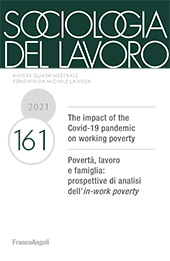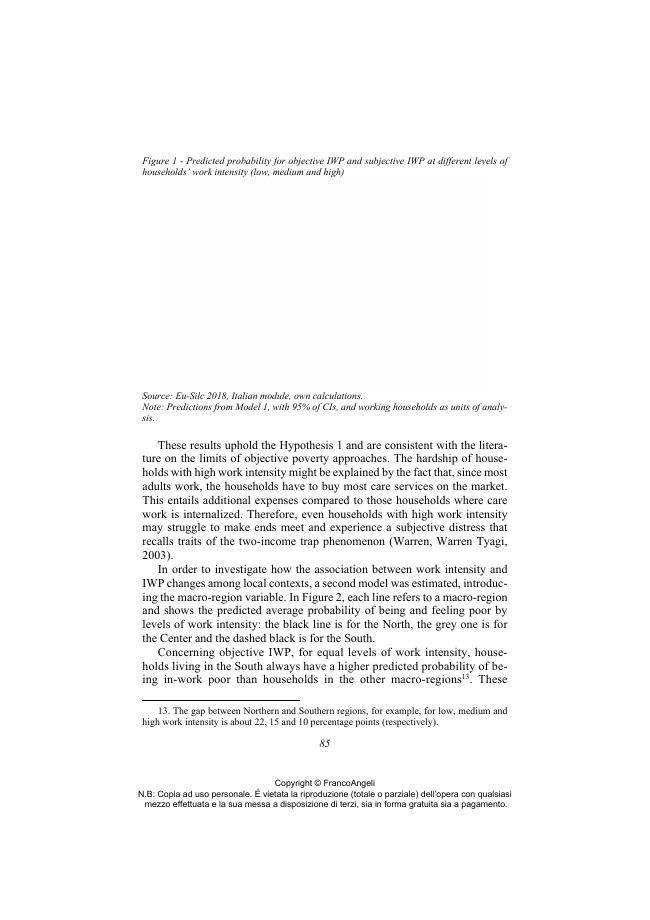In-work poverty and regional disparities : an analysis of the relationship between work intensity and the probability of being and feeling poor across Italian territories
73-96 p.
Work intensity is considered one relevant factor in shaping the risk of experiencing inwork poverty, i.e., being a worker with a household income below the relative poverty line. However, little attention has been paid to how work intensity is associated with workers' subjective poverty (i.e., their feeling of being inwork poor) and to how this association varies across geographical areas. Therefore, the present work intends to fill this gap and investigate the relationship between workintensity and the risk of experiencing inwork poverty, in both objective and subjective terms as well as differences among local contexts, i.e., regions and degrees of urbanisation. The analysis is based on 2018 crosssectional data from the Italian module of the EuSilc survey. Empirical results show that work intensity is negatively associated with both objective and subjective inwork poverty, but the relation is stronger with the former.
Furthermore, densely, intermediate and thinly populated areas show similar trends, whereas there is a persistent gap between, on the one hand, the NorthCenter of Italy and, on the other, the South, which has the highest risk of objective and subjective inwork poverty. However, the latter is also the area where the association between work intensity and inwork poverty is stronger. [Publisher's text].
L'intensità di lavoro è uno dei fattori che più influenza il rischio di essere lavoratori poveri, ovvero essere lavoratori che hanno un reddito familiare disponibile al di sotto della soglia di povertà relativa. Ad oggi vi sono alcuni aspetti della relazione tra intensità e povertà da lavoro rimasti inesplorati, ad esempio, come tale relazione possa variare da un territorio ad un altro o come l'intensità da lavoro possa influenzare la povertà soggettiva dei lavoratori (la loro probabilità di sentirsi poveri). Il presente articolo indaga la misura in cui l'intensità di lavoro influenza la probabilità delle famiglie lavoratrici di essere e sentirsi povere e con quali differenze da un territorio ad un altro. L'analisi è condotta sul caso studio dell'Italia utilizzando i dati trasversali 2018 dell'Indagine sul reddito e sulle condizioni di vita (EuSilc).
Per mezzo di modelli di regressione logistica binomiale, si osserva che l'intensità di lavoro influenza negativamente sia la povertà da lavoro oggettiva sia quella soggettiva, ma che ha un effetto maggiore nel primo caso. Inoltre, l'analisi mostra che vi è un gap persistente tra, da un lato, le regioni del centronord Italia e, dall'altro, quelle del sud, dove la povertà da lavoro oggettiva e soggettiva è più alta. Tuttavia, queste regioni sono anche quelle in cui l'intensità da lavoro incide maggiormente sulla probabilità di essere e sentirsi poveri. [Testo dell'editore].
Fa parte di
Sociologia del lavoro : 161, 3, 2021-
Articoli dello stesso fascicolo (disponibili singolarmente)
-
Informazioni
Codice DOI: 10.3280/SL2021-161005
ISSN: 1972-554X
PAROLE CHIAVE
- inwork poverty, instabilità lavorativa, povertà soggettiva, disparità territoriali
- Inwork poverty, Work Intensity, Subjective Poverty, Territorial Disparities



